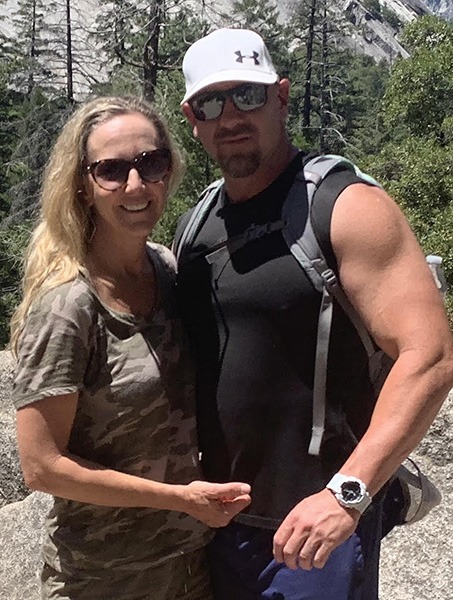Never Let Em See You Sweat!!!
That was the tag line for Dry Idea anti-perspirant back in the 80’s. Since then, the same line has been used for book titles, song titles, even anti-bullying campaigns. But, do we REALLY never want them to see us sweat? That is the question…
Of Course Not!
Sometimes, actually MOST of the time, It’s GREAT to let em see you sweat. Sweat shows hard work and perseverance. It let’s the world know, you’ve got drive. No Pain, No Gain!
The Story of the Sweat Bead
Sweat is comprised mostly of water but it also contains sodium, chloride, potassium, calcium and magnesium. Someone who is not very in shape tends to lose more sodium in their sweat than a person who is fit. But everyone’s sweat is slightly different.
Some individuals will lose more sodium in their sweat than others. If your sweat is salty — meaning it stings your eyes, leaves a gritty feeling on your skin or produces a sting on an open wound — you’re losing sodium, which you can replace with a sports drink.
The volume of sweat you produce depends on a variety of factors:
- Body size: Bigger people generate more heat because they have to move more body mass, so that means more heat generated and hence, more sweat. The greater surface area that comes with a larger body also requires more perspiration to cool it down.
- Age: Your body becomes less tolerant to heat as you age. Sweat glands change with age, reducing the body’s ability to cool itself effectively.
- Muscle mass: Muscle mass produces more heat than fat. If two people have the same body weight, their sweat rate will differ based on their percentage of muscle mass.
- Health status: A number of health conditions and life stages can impact how much you sweat. Colds, flu and even mental health conditions such as anxiety and depression can impact how much you sweat. Hormone fluctuations in particular are often linked with an increase in internal body temperature. (Just ask any perimenopausal or pregnant woman!)
- Fitness level: People who are very fit sweat more than their less-fit counterparts. But if fit people and less-fit people are performing the same task, the less-fit person will sweat more because they have to expend more energy to perform the same task.
Sweating and Fitness
During exercise in temperate conditions, the average person will lose about 1.5 to 2 liters of fluid through sweat. Add high humidity and heat to the mix and your rate of fluid loss can double.
If you’re exercising or playing sports for more than one hour, it’s important to replace the fluid you lose through sweat during the activity to prevent dehydration. Here’s how:
- Sip on a sports drink containing carbohydrates and electrolytes (sodium chloride, potassium, calcium and magnesium).
- Replenish lost fluids with 16 to 20 ounces of fluid per hour (four to six ounces for every 15 to 20 minutes)
Exercising for less than one hour? Opt for water over a sports drink, but make sure you hydrate sufficiently.
What the Docs Have to Say About Sweat…
If you’ve ever finished a workout and found yourself disappointed not to be drenched in sweat, you’re not alone — many people consider sweating profusely to be a sign of vigorous exercise.
But you don’t need to sweat to get a good workout, according to Dr. Lindsay Baker, sweat expert and principal scientist at the Gatorade Sports Science Institute.
Baker told Insider that many factors can influence overall sweatiness, and research on how and why people sweat can offer valuable insight into how the human body adapts to exercise and recovers afterward.
Research Suggests…
the more an athlete works out, particularly doing aerobic activities such as distance running, the sweatier they tend to be.
“All other things being equal, the more endurance training you do, the more you’ll sweat, and you’ll also start sweating sooner,” she said.
Paying attention to how much you sweat offers insight into your overall fitness level, and help you both prepare for a grueling workout and bounce back more quickly afterward.
Sweating less in a workout isn’t necessarily a cause for concern
Intensity is just one factor in how much you sweat. Generally, the more effort you exert, the more heat your body generates, which triggers the body to produce more sweat, according to Baker.
That’s because sweat functions as the body’s cooling system. When you start to heat up, during exercise or otherwise, your sweat glands produce liquid on the surface of your skin. As that liquid evaporates in contact with the air, it uses energy in the form of heat from your skin, helping stabilize your body temperature.
But how much you sweat is based on personal factors like genetics, gender and weight. People with more body mass, for instance, tend to sweat more, since it requires more effort to move the larger mass than it does for a smaller person.
Where You Work Out…Matters
Environmental conditions like ambient air temperature and humidity also determine how quickly sweat evaporates, and therefore how much you see (and feel) on your body.
“How visible the sweat is on your skin varies depends on a lot of factors,” Baker said. “Outside in dry, windy conditions, you could be sweating a lot but won’t necessarily notice it.
Depending on these factors, you might work out without sweating much at all, and that doesn’t necessarily mean you didn’t work hard, or that you’re dehydrated.
Similarly, there’s no need to be alarmed if you’re sweating a lot. In researching hundreds of athletes, Baker has found that the average amount of sweat is about a quart per hour, but that can vary widely, from less than half a quart to three quarts or more.
So, while sweatiness is one way to judge the quality of your workout experience, it’s not the only factor.
Fit people tend to sweat more, as their bodies adapt and they’re able to sustain higher intensity workouts
How much you sweat is also determined by how much fitness experience you have, particularly with endurance training, according to Baker.
That’s because the body learns to anticipate an impending workout as soon as you start warming up, and springs into action to start cooling you down by producing sweat.
“If you’ve become adapted to exercise, your body responds by becoming better able to regulate your body temperature by starting to sweat sooner and more so you can dissipate heat and keep your core temperature at a safe level,” Baker said.
Well-trained athletes are also able to sustain higher levels of intensity during their workout, which also generates more sweat, she said.
The sweatiest athletes, according to Baker, are endurance runners, but American football players are a close second, since the sport requires heavy equipment and some roles (such as defensive lineman) require a higher body mass.
Regardless of how much you sweat, don’t forget to hydrate
One side effect of sweating is that you lose fluids and electrolytes (minerals essential for health, like sodium and potassium), which you then need to replenish or risk dehydration.
The easiest way to keep track of hydration is through your urine. If it’s dark in color or infrequent, you’re likely not drinking enough water.
One solution is to be proactive and start sipping before you work out.
“A lot of athletes don’t think about drinking and hydrating during the day. “It’s really important to think about hydration 24/7. ”
The amount you sweat matters here. Baker said you can gauge how much you’re sweating by weighing yourself before and after. If you weigh less, that indicates you need to drink more fluids to replace what you’ve lost in the sweating process.
Eating a salty snack along with your post-workout drink can also help replace electrolytes, Baker said, so you can avoid side effects like excessive fatigue and muscle cramping.
Tip of the Day:
Here are 5 natural electrolyte boosters:
Sea salt
Sodium is one of the electrolytes that we’re quickest to lose through sweat. Luckily, ingesting salt is a quick and easy way to replace what we lose. Salt also contains the electrolytes magnesium, calcium and potassium; so it’s good for more than just sodium replenishment. Go for sea salt over table salt because it’s less processed. Himalayan and Celtic sea salts are widely available in most grocery stores. Just put a pinch in your water and drink. It’s that easy.
Coconut water
Packed with nutrients and low in sugar, coconut water is a great way to rehydrate and replenish electrolytes, especially potassium. There are a lot of coconut waters on the market. Look for one with minimal ingredients, especially anything that looks artificial. Harmless Harvest uses only organic coconuts and is never cooked or boiled. Their minimal processing causes some of their coconut waters to turn pink when the antioxidants are exposed to light—it’s still totally safe to drink. If you have access to it, completely unprocessed coconut water, directly from the coconut, is always best!
Natural Calm
Magnesium is one of the most important electrolytes to keep replenished, since being magnesium deficient can cause insomnia, anxiety, muscle cramping, constipation and other problems. Natural Calm is a drinkable magnesium supplement that contains highly absorbable, water-soluble magnesium. Drinking a glass every night before bed is a great way to keep your magnesium levels on track. You can up the dose in hot weather or if you’re exercising a lot.
Lemons
Lemons are the queen of citrus when it comes to electrolytes. They’re a good source of potassium, calcium and magnesium. Add that to their ability to detoxify the liver, balance pH levels and boost the immune system with vitamin C, and lemons are officially a solid addition to any drink. Squeeze a whole lemon into warm or cold water for a sour jolt of electrolytes.
Green vegetables
No list is complete without a reminder to eat more green vegetables—and electrolyte replenishment is no exception! Leafy greens such as kale, swiss chard, beet greens, bok choy and spinach are packed with electrolytes. They are especially rich in magnesium, calcium and potassium. Celery, broccoli and avocado are good sources as well. You can add an electrolyte punch to any meal by tossing in something green.
Cheers to LETTING them See You Sweat!!!!

